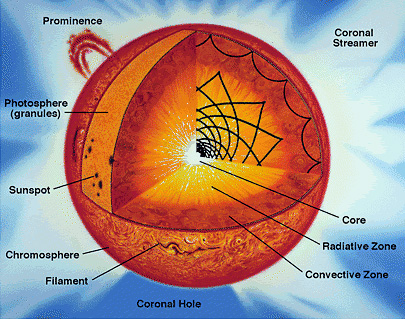Sun
Our parent starSelf-luminous object held together by its own self-gravity. Often refers to those objects which generate energy from nuclear reactions occurring at their cores, but may also be applied to stellar remnants such as neutron stars.. The structure of Sun’s interior is the result of the hydrostatic equilibriumBalance between gravity and gas pressure. In the case of a star, gravity originates in mutual gravitational attraction of the entire mass of the star. Gas pressure is produced by nuclear reactions that heat the star's gas. Any change in the internal temperature of a star results in a change between gravityAttractive force between all matter - one of the four fundamental forces. and the pressure of the gas. The interior consists of three shells: the coreIn the context of planetary formation, the core is the central region of a large differentiated asteroid, planet or moon and made up of denser materials than the surrounding mantle and crust. For example, the cores of the Earth, the terrestrial planets and differentiated asteroids are rich in metallic iron-nickel., radiative region, and convective region.

Image source: http://eclipse99.nasa.gov/pages/SunActiv.html.
The core is the hot, dense central region in which the nuclear reactions that power the Sun take place, temperatures range from 8-15 x 106 K with densitiesMass of an object divided by its volume. Density is a characteristic property of a substance (rock vs. ice, e.g.). Some substances (like gases) are easily compressible and have different densities depending on how much pressure is exerted upon them. The Sun is composed of compressible gases and is much from 10-160 g/cm3. It comprises about 25% of the interior radius. The core is the region where the energy of the Sun is produced. DensityMass of an object divided by its volume. Density is a characteristic property of a substance (rock vs. ice, e.g.). Some substances (like gases) are easily compressible and have different densities depending on how much pressure is exerted upon them. The Sun is composed of compressible gases and is much and temperature are high enough to cause nuclear fusionProcess in which two lighter atomic nuclei combine to form a heavier atomic nucleus. Very high temperatures are normally required in order for atomic nuclei to collide with sufficient energy to overcome the Coulomb barrier (their mutual electrostatic repulsions). Fusion that occurs under high-temperature conditions is called thermonuclear fusion. Fusion reactions. These reactions release energy both in the form of γ-rays and particles (in particular neutrinos).
The radiative zonePortion of a star where the primary transport of energy is by photons (electromagnetic radiation). extends from ~25% to 85% of the solar radius. Here, and in the core, the primary transport of energy is by the movement of photons; temperatures range from 0.5-8 x 106 K with densities from 0.01-10 g/cm3. The radiative zone is not transparent. On average, photons only ~2 cm before being scattered in a random direction by an encounter with an electron. The resulting "drunkard’s walk" is very inefficient and it typically takes ~170,000 years for energy generated in the core to escape to the surface.
The convective zoneRegion within a star, where the change in temperature with increasing radius is so rapid that energy transfer occurs by convection (rapid up and down motion of large packets of gas). starts at ~85% of the solar radius and extends to just below its surface; its density is <0.01 g/cm3. In this region, the change in temperature with increasing radius is so rapid (0.1-5 x 105 K) that the interior becomes unstable and undergoes convectionTransfer of heat energy by moving material. Temperatures increases with depth in planetary objects. Deep hot less-dense material physically rises and cools, releasing heat and becoming denser. The now cooler denser material sinks back into deeper regions, where it will be reheated and rise again. Convection is an important mechanism (rapid up and down motion of large packets of gas). Convective movement is responsible for the granulation pattern seen on the surface.
Basic data for the Sun: RSun = 7.0 x 105 km; MSun = 2.0 x 1030 kg;
ρSun = 1.4 g/cm3; Composition: 74% H, 25% He, 1% other elements; Tsurface = 5800 K; LSun = 3.9 x 1026 W.






